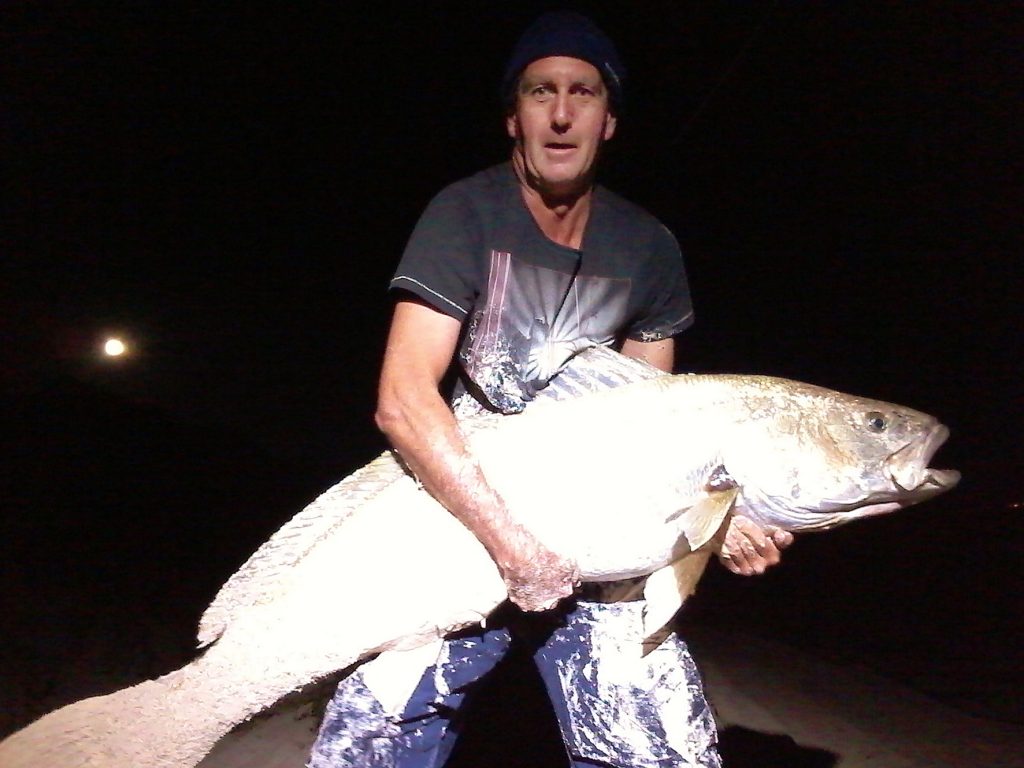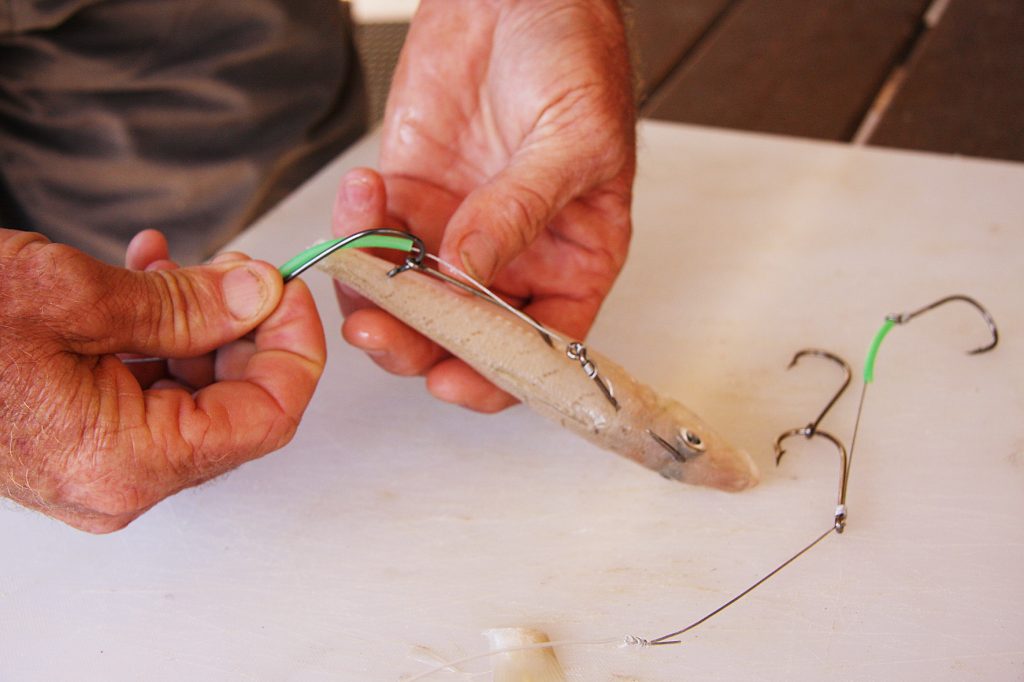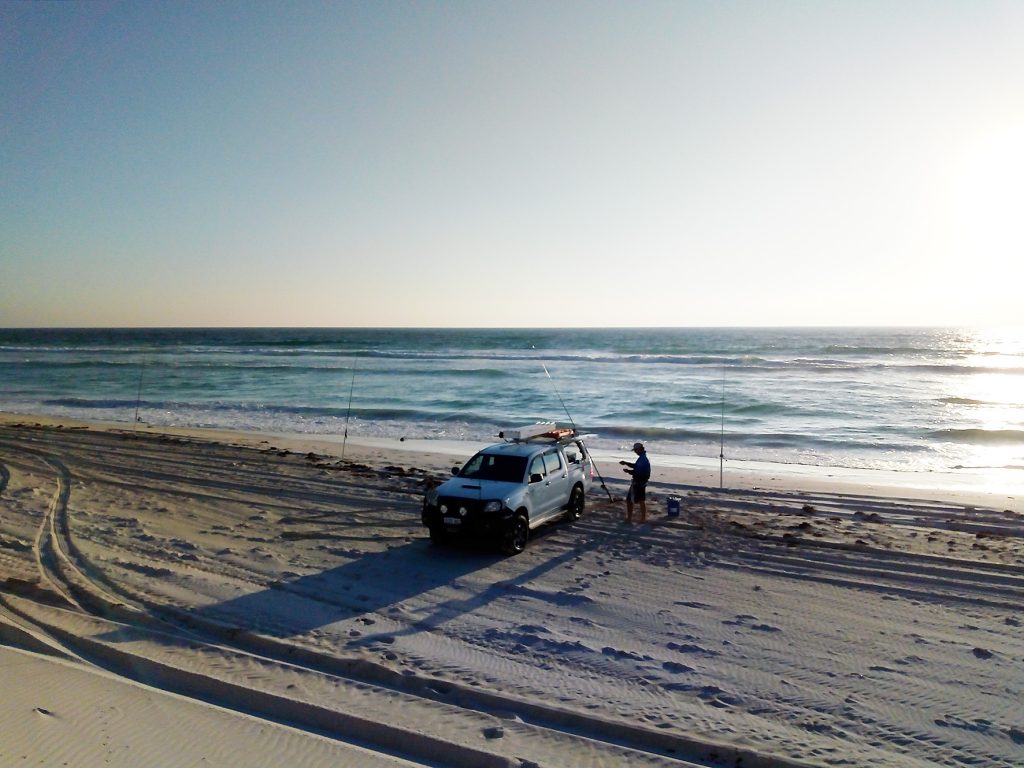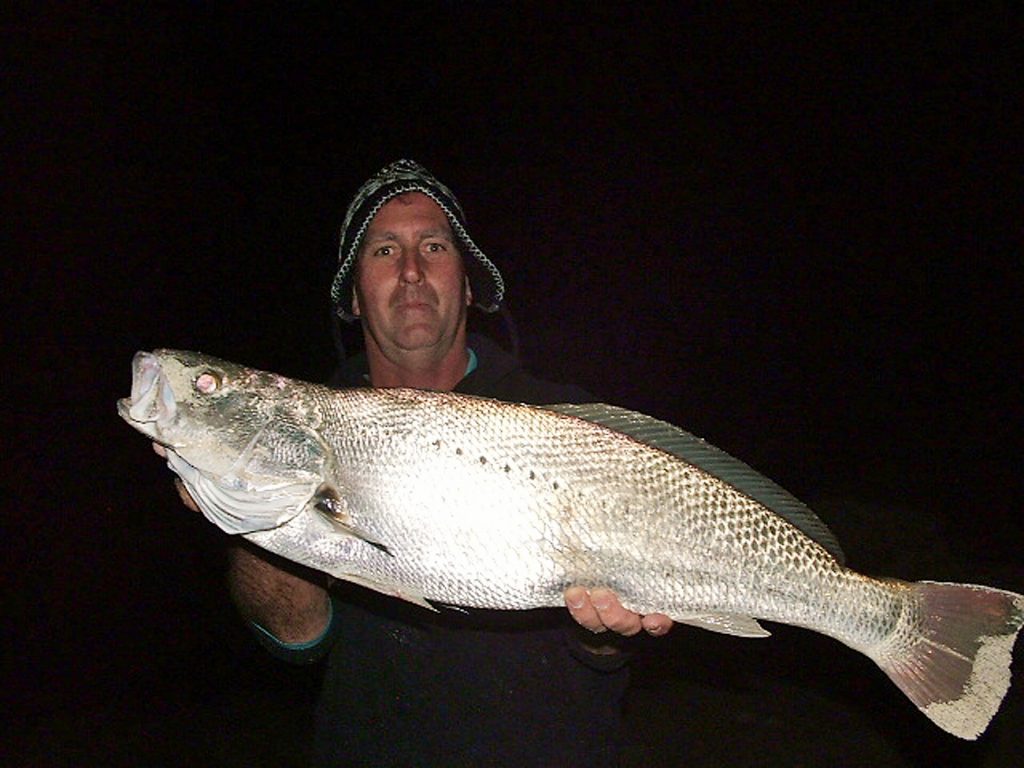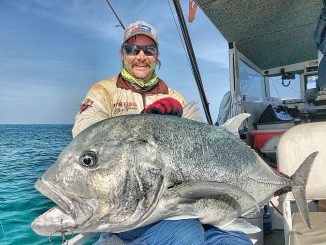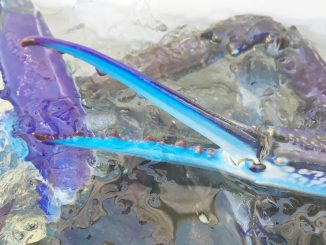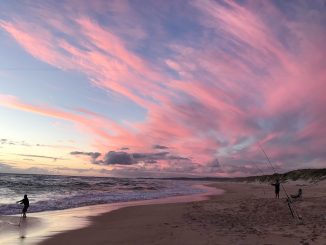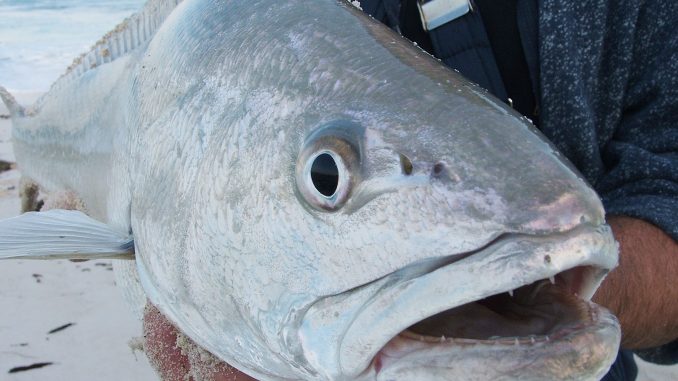
by Peter Fullarton •
Mulloway can be caught in a number of environments such as estuaries, rivers, bays and offshore, but one of the mulloway’s favourite hunting grounds is the ‘surf zone’. Chasing them in each environment requires an understanding on what they are eating and how they are behaving. This article deals specifically with the surf zone and the techniques to target them in the difficult turbulent conditions.
Mulloway are the king of all beach fishes, as they are elusive and full of mystique. To beach fishers, they are sometimes known as the silver ghost or the mythical silver unicorn. Rarely do they come easily! Usually there are a considerable number of hours, missed opportunities and lost fish before finding some success and starting to unlock the secrets to finding, hooking and landing them on a regular basis from the surf.
Where and when to fish
Mulloway like structure and turbulent, aerated water. They are not the type of fish to be reliably found on just any beach. Choose the right beach known to hold fish and concentrate your efforts there. Look for beaches with near-shore reefs and or well-formed holes and gutters and good surf turbulence.
Mulloway can be caught at any hour of the day or night, although they are more comfortable close into the beach from when the light starts to fade in late afternoon, early to mid-morning and the hours of darkness in-between.
Prime times are dawn and dusk, especially when either coincides with a tide change. Most beach gutters will be at their best on an incoming or a high tide. The larger tides of the full and new moon are prime. At low tide many gutters are too shallow for the fish to hunt successfully, and as the high tide comes in fish move into the gutters to feed, narrowing the bite time and concentrating the feeding window within a certain time period.
Success during daylight hours will be greatly determined by the tides and conditions. If a gutter is formed well with good depth and creating enough stirred up sand and foam to provide cover for the fish to ambush prey, there will be a chance to capture one no matter what the time of day. On overcast days fish are more likely to be actively hunting.
Study the beach structures, reefs, holes gutters and rips and the way the waves and currents interact with them. Think about how the mulloway will use stirred up sand and aerated water as cover to hunt. Place your baits with that in mind. It is not just as simple as cast out and wait. Try placing baits under the foam where a wave breaks over a reef or bank on the outside of a gutter.
The near-shore edge of a deep gutter where the sand is stirred by the wave breaking on the shore is another good place to try. The stronger current edges and eddies give mulloway a place to rest while waiting for prey to be swept past in the current. Additionally, look for where the plumes of sand start to disperse and settle at the seaward end of a rip.
Baits, rigs and tackle
Mulloway are an ambush predator, preferring to use low light and murky, sandy or aerated waters to capture whole prey, with fish, crabs and squid being some of their favourite baits. Live baits are highly desirable, although they’re not always practical on a surf beach. With a strong swell, current, wind and plenty of seaweed around, it can be very difficult to present the baits in a natural way and lines may need to be retrieved and re-cast frequently. Live baits won’t stand up very well to frequent recasting. If conditions allow, certainly use them, but just remember pick the days when the bait can be presented well and left out for a while if you want to use live baits.
Whole dead fish baits or fillets are more commonly used under strong surf conditions, and the fresher the better. Popular baits are squid, mullet, herring, tailor, pilchards and whiting. Mulloway have holding teeth and crushing teeth. They do not cut up their food like a tailor, and tend to swallow food down whole and head first. Whole fish will not slide down the gullet backwards, as the dorsal and anal spines will hurt the fish. This knowledge is crucial in being successful and determines both how the bait is presented on the rig and fishing technique!
Fishing in surf, a long rod of at least 3.65-4m is generally required, although serious fishers may have a range of options up to 4.5m to cater for all conditions. The long rods allow the fisher to hold or to set the rod in a holder, so the fishing line sits above the breaking waves. If the line were to fall into the breaking waves, it would likely pick up weed and be dragged into the surf and the bait would need to be reset each time this happens.
Spinning reels are a popular choice, and I prefer to use one with a ‘bait runner’ function. The rod can be placed in a holder with the free spool tension set just so the line remains taught. The fish is free to play with the bait, or run if it picks up the bait, and in this way you don’t lose your setup along with the fish.
Line choice is a personal preference and many options will work. Braid gives you a good feel for the bites and the thin diameter gives less resistance to the wind and current to keep the line tight. Mono can withstand rubbing on rocks, will give a better stretch to keep line tight during mulloway headshakes, and tends not pick up so much weed. My own personal preference is around 400m of 15-18kg braid, with a 4m 35kg mono shock leader to protect it from rocks. Tying the leader to the braid via a FG knot gives near 100% of the braid breaking strain, whereas if you were to tie the braid direct to a swivel you would lose 20-30% of the line’s strength. I find to go any heavier detracts from the experience. Average size fish will give a good account of themselves on 15kg line and test the angler’s skill, while still giving enough reserve should that fish of a lifetime come along.
Most mulloway fishers will develop their own variations on refining a rig to suit the type and size of baits they use and beaches they fish. Some people use running sinkers while others will use a paternoster style rig with a three-way swivel. In an ideal world, the mulloway would be allowed to run with the bait to be sure it has swallowed it properly. More often than not in the surf, there will be current and probably some weed on the line and the fish will feel considerable resistance. My preference is to have the sinker running so the fish feels the least amount of resistance possible, and on the right day there will be next to none. Sinker weight and design is determined by conditions. A light spoon type sinker can be cast into a rip and fed out with the current, as the bait will drag it along further to sea. Star or grapnel sinkers will anchor the bait against a strong cross current or wind, just try to choose the lightest for the available conditions.
The bait will dictate the best method of setting up the hooks. Pilchards are great bait and mulloway love them, they are soft, so a gang of hooks works best and holds the bait on the hooks very well. As mulloway may play with the bait for some time, I prefer a whole tougher fish or fillet bait.
Whole fish with firm flesh mean gang hooks stay buried inside the bait when it is swallowed, causing missed hook-ups. To prevent the hooks failing to find a hold, it is best to snell together two circle or octopus style hooks. The length of the snell is largely dictated by the size of the bait. Ultimately, you want the line laying flat along the length of the bait. Thread the bottom hook through the bait’s body 2-3 times before pushing the point in just behind its head and turning it back through the gill plate or eye, so the point is exposed and pointing towards the baits tail end. Then place the top hook either through or around the backbone near the bait’s tail, turning the point back in the same manner. When the bait is swallowed head first, the exposed hook points should find a good hold. As you are putting the bait on upside down, there is potential for the mulloway to pull the bait off the tail end hook quite easily, so the use of some elastic bait string will help hold the bait onto the soft tail better.
For my own go to rig, I use a hybrid rig consisting of two ganged hooks and a snelled octopus style for my whole fish baits. It gives an excellent hook-up rate on both tailor and mulloway, and having double the hold on the bait’s tail end it can’t be pulled off the hooks so easily. There is no need to thread the first hook through the fishes’ body, so all three hooks are effectively holding the weight of the bait evenly.
Hook size will be best chosen once you’ve decided what bait you use. A 6/0 is a good size for fillets such as whiting and pilchards, where you may want to go up to 8/0 for larger mullet and herring baits. I like to incorporate a little lumo tube near the hooks for that little added attention when fishing on dark nights.
Casting heavy whole baits strung backwards any distance is challenging. To get more distance out of the cast, remove the tail and pectoral fins with a set of sharp scissors, as this lowers the wind resistance. Additionally, use a breakaway sinker or clip to attach the bait directly to the sinker during the cast so it does not flail behind like a parachute.
On the topic of wire traces, I do use one when snelling two hooks together and don’t seem to catch any less fish than the person next to me. This is because the majority of bites where I fish chasing mulloway come from tailor, and they will quickly damage the line between the snelled hooks. You need to check and re-tie hooks if the line is damaged after every tailor bite, wasting time or risking missing the next mulloway to swim into the zone. Try to keep the wire as light as possible, and use a plastic coated one if you can. I find if tying snelled hooks with wire, 30kg is a minimum and the wire must be replaced after every session. Otherwise, the point where the second hook swings off the first the wire will weaken and will eventually fail, especially if you’ve been catching a lot of tailor, which shake and rattle around on the hooks. If you choose not to use wire, then be sure to use a heavy leader of around 50kg to reduce the tailor bite-offs.
Mulloway will respond well to berely, but you must read the situation well. Poorly-applied berley on a surf beach will move the fish away from where the baits are. If you have a nice eddy in a hole your baits are in, then throwing in handfuls of chopped pilchards will work well to attract and keep fish near the baits. There is no point throwing handfuls of chopped pilchards into a strong rip, as the pilchards will be washed out to sea with any mulloway following along. In a strong rip your best to use a berley bag anchored in the surf to create a scent trail that the mulloway can follow to your baits. Study the currents well and position your berley bag so the scent will pass the baits, it may need to be positioned down current to your fishing location.
The technique
There is no classic ‘textbook’ bite, as each one will be perceived differently at the fishing rod. The main idea is to give the fish the time it needs to eat the bait and not spook the fish with a harsh jerk on the rod to set the hook until you are sure the bait has been taken properly. Mulloway may pick up the bait and crush it, as if to kill it, then if it is happy with the hold it has, it may swallow the bait head first while moving off. If it feels resistance it may spit the bait out, but still return and try again. This may take minutes. Sometimes it will need to suck it in and spit it out several times before it is happy the bait is positioned right to swallow head first!
You must resist the urge to do anything until the fish starts to move away and the rod tip starts to load up with the weight of the fish before attempting to set the hooks. Other times you may not notice anything until the rod is almost wrenched from your hands. Presume everything is a mulloway until you know better, and resist the urge to strike.
Keep in mind, a large fish may crush the bait and then take several minutes to turn around and come back to swallow it down. If it is calm enough to properly feel what the fish is doing and you have a running sinker walk towards the fish as it moves off with the bait, it will give the fish slack line to swallow the bait down well. The reality on a surf beach, with current most the time, is that it’s best to just let the rod tip load up before setting the hooks. When using pilchards, baits won’t stay on the hooks for long, so it is best not to let the fish run with the bait, but rather to strike as soon as the fish has the bait in its mouth.
Once a fish is hooked, it will become obvious if you have a mulloway on, as they have a classic head shake rattle as they try to dislodge the hooks, and often they may just stop on the spot and shake from side to side. Mulloway will change direction in a fight, so be on your toes! If you think it is gone, don’t give up, wind in quickly, because it is just as likely the fish has turned and is heading straight for you. Try to keep the line tight throughout the fight, or it may be successful with those head shakes at throwing the hooks free.
As the fish comes into the surf break, it may be picked up in the breaking swells and rolled in a wave, so wind fast and walk backwards at the same time to keep that line taught. Once you finally have the fish beat at the shore, time it with a wave to pull the head around. As the wave hits the fish, you should be able to surf it in head first, bringing it up as far and as fast as you can and beaching it high and dry. Run to the fish and grab it before the next wave comes in.
To pick up mulloway you can put your fingers inside the gill opening and slide towards the throat before lifting with a hand under the belly to support the fish. Only put your fingers just inside the gill opening and not into the gills themselves. If your fingers do go inside the gills, the rakers won’t easily let your fingers back out without some damage. If you got to this stage however, I am sure you won’t really care, as it is going to take more than losing a little bark to wipe that smile off your face!
If you want to let the fish go after some quick pictures, wade out to some deeper, clear water to swim the fish and make sure it has a strong enough kick to swim off. Avoid swimming the fish in the sandy surf at the waters edge, as the gills can slime up while they are out of the water and the sand sticks to the gill slime, suffocating the fish.
A few other notes
I recommend you keep a diary recording when you go fishing for mulloway, not only when you catch or drop a fish, but also the occasions when you don’t get any bites. Take note of baits, times, dates, moon phases, tides, conditions and any the specifics of each capture or missed take. Over time you can build up a picture that will greatly help increase your successes.
Become something of a perfectionist! Considering the amount of effort and time that can go into just getting a mulloway to take a bait, each lost opportunity may be the difference between a successful fishing trip or a failed one. Take note every time something goes wrong and implement a plan or strategy to prevent the same thing ever happening again. You can believe me, there is nothing worse than losing a hard-earned fish to a stupid mistake. Learn from each experience, as it can be the difference between a good fisher and a mediocre one.
Mulloway can travel in small or large groups, so be quick to get bait out after catching one.
Don’t go flashing about bright LED headlights to sea, as they will spook the fish. I leave on an overhead downlight light on the beach hung from the top of a fishing rod. You can clip chemical light sticks to your rod tips to see the bites.
Test all your knots and rigs and be aware of what the breaking strains are and where the weakest links are, and be prepared to adapt and change your knots or materials to reduce any weaknesses.
Have all your rigs pre-made. You don’t want to have lines out of the water at the best bite time just because you needed to re-tie a rig. I will even have an extra rod rigged and ready to go.
Don’t reuse old rigs. After a trip, re-tie all your gear, including any FG knots and replace shock leaders.
Check hooks after getting snagged for broken or burred edges and re-sharpen as required.
And finally, tailor can bite shiny sinkers or swivels, instantly cutting the mainline when the line is stretched taught while battling a mulloway. Put sinkers on droppers and use small black swivels to avoid this!
Good luck and tight lines on your next mulloway fishing adventure!


